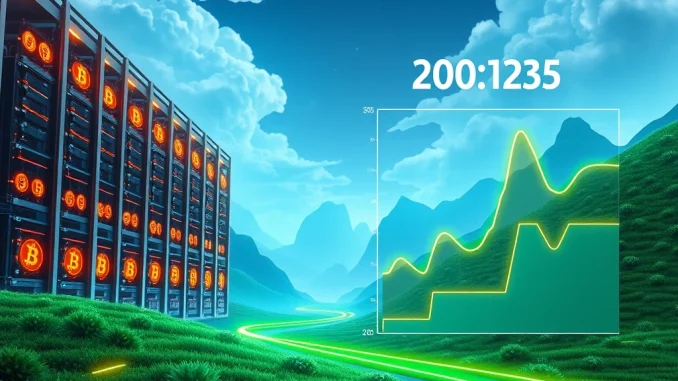
Hey crypto enthusiasts and tech watchers! We’ve all heard plenty about the energy demands of Bitcoin mining. It’s been a hot topic for years, often cited as a major challenge for the network. But what if another rapidly growing technology is poised to dwarf Bitcoin’s energy footprint? A recent forecast suggests that AI power consumption could soon become the dominant energy story, potentially surpassing Bitcoin mining as early as 2025.
Understanding the Massive Energy Demands
The projection comes from Alex de Vries-Gao, a PhD candidate at Vrije Universiteit Amsterdam, known for his work on Bitcoin’s environmental impact. According to a report by Digital Today, de Vries-Gao estimates that AI’s electricity consumption is already significant, accounting for up to 20% of the total energy used by data centers globally. This figure alone highlights the immense scale of resources required to train and run sophisticated AI models.
Let’s break down why both technologies are so power-hungry:
- Bitcoin Mining: Relies on a Proof-of-Work consensus mechanism. Miners use specialized hardware (ASICs) to solve complex computational puzzles. This process requires significant electricity to power the machines and cool the facilities housing them. The energy expenditure is directly tied to securing the network and validating transactions.
AI Workloads: Primarily driven by training large neural networks and running inference (applying trained models). Training models like large language models (LLMs) involves processing vast datasets over extended periods on powerful hardware like GPUs. Inference, while less energy-intensive per query than training, is performed billions or trillions of times daily across countless applications, leading to substantial cumulative energy use.
While the mechanics differ, the result is the same: a substantial demand for electrical power.
Comparing AI vs Bitcoin Power: The Forecast
De Vries-Gao’s projection is striking: AI-related power demand could reach an estimated 23 gigawatts (GW) by the end of 2025. To put that into perspective, 23 GW is roughly equivalent to the total electricity consumption of the entire United Kingdom. This forecast indicates a rapid acceleration in AI’s energy footprint.
Comparing this directly to Bitcoin energy use is complex, as Bitcoin’s consumption fluctuates based on price, network difficulty, and technological advancements. However, various estimates place Bitcoin’s current annualized consumption somewhere in the range of 10-15 GW. If AI demand hits 23 GW by 2025, it would indeed represent a significant overtaking.
Here’s a simplified look at the potential shift based on the forecast:
| Technology | Estimated Current Power Demand (GW) | Forecasted Power Demand by End of 2025 (GW) |
|---|---|---|
| Bitcoin Mining | ~10-15 | Variable (potentially similar or slightly higher) |
| Artificial Intelligence (AI) | Significant (up to 20% of data centers) | ~23 |
Note: These are estimates and forecasts; actual figures can vary.
What Does This Energy Consumption Forecast Mean?
This potential shift has several key implications:
- Increased Scrutiny on AI: Just as Bitcoin has faced criticism for its energy use, AI is likely to come under similar, if not greater, scrutiny as its consumption grows.
- Strain on Infrastructure: The demand for significant power, often concentrated in specific locations housing large data center electricity infrastructure, could put pressure on local and regional power grids.
- Push for Efficiency: Both industries face pressure to become more energy-efficient. For Bitcoin, this involves optimizing hardware and exploring renewable energy sources. For AI, it means developing more efficient algorithms, specialized hardware, and optimizing data center operations.
- Policy and Regulation: Growing energy demand from these technologies could prompt policymakers to consider regulations related to energy reporting, efficiency standards, or carbon emissions.
- Reframing the Narrative: While Bitcoin’s energy debate won’t disappear, the rise of AI’s massive energy needs might shift the broader conversation around technology’s environmental footprint. The discussion might move towards the energy cost of *all* advanced computation, rather than focusing solely on cryptocurrencies.
Challenges and the Path Forward
Accurately measuring the energy consumption of both AI and Bitcoin is challenging due to varying methodologies, data sources, and the dynamic nature of these fields. However, the trend highlighted by this energy consumption forecast points towards a significant challenge.
The path forward for both AI and Bitcoin involves innovation in energy efficiency and a move towards sustainable energy sources. Companies developing AI hardware and software are actively researching ways to reduce the computational cost of models. Similarly, the Bitcoin mining industry continues to explore geothermal, hydro, solar, and wind power opportunities, sometimes utilizing energy that would otherwise be wasted.
Conclusion: A New Energy Frontier
For years, Bitcoin energy use has been a central point of discussion regarding its environmental impact. However, as artificial intelligence rapidly advances and becomes more integrated into our lives, its energy demands are projected to escalate dramatically. The forecast indicating that AI power consumption could surpass Bitcoin mining by 2025 highlights a critical turning point.
This isn’t just a technical detail; it’s a signal about the growing energy footprint of advanced computation itself. As both AI and blockchain technologies continue to evolve, managing their energy demands responsibly will be paramount for sustainable growth. The conversation is shifting, and the future of energy consumption in the digital age looks set to be dominated by the immense power requirements of AI.



